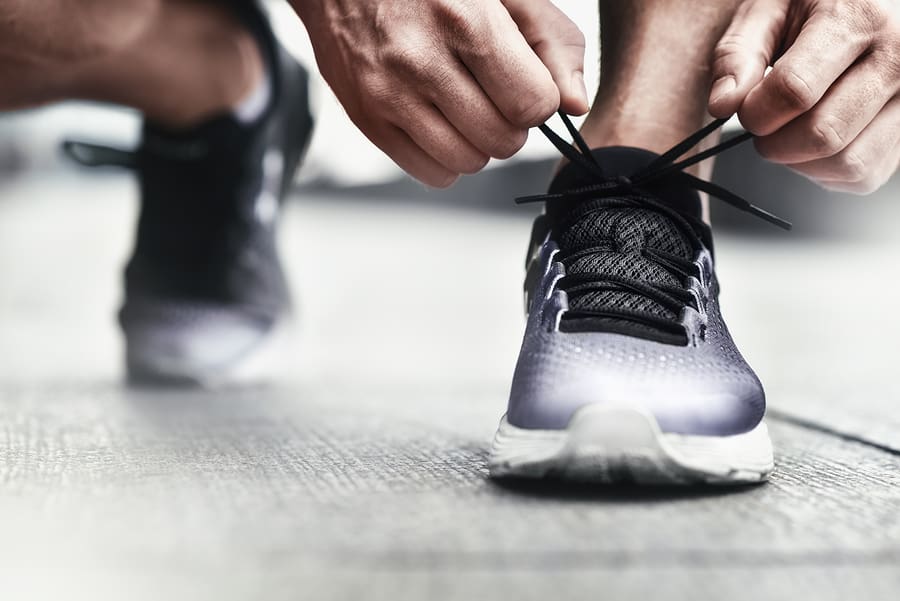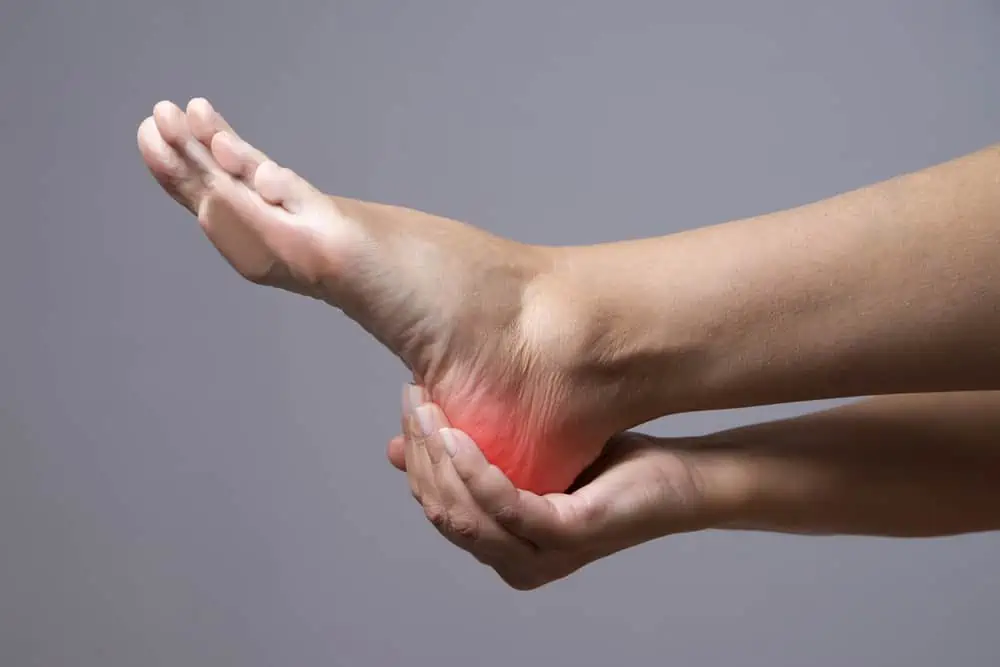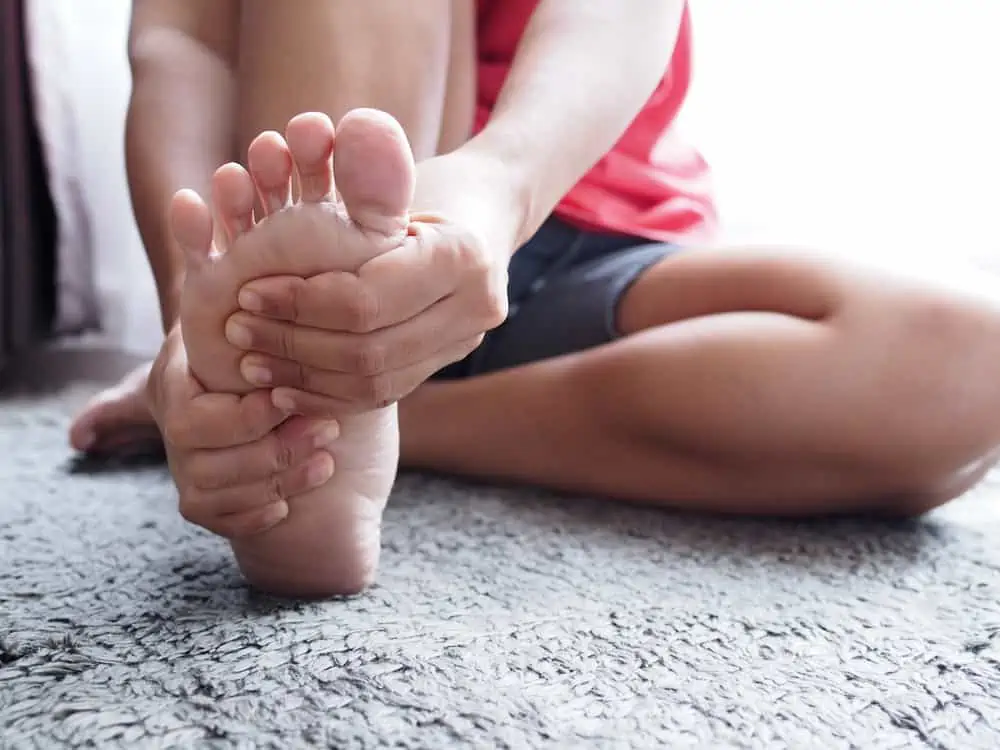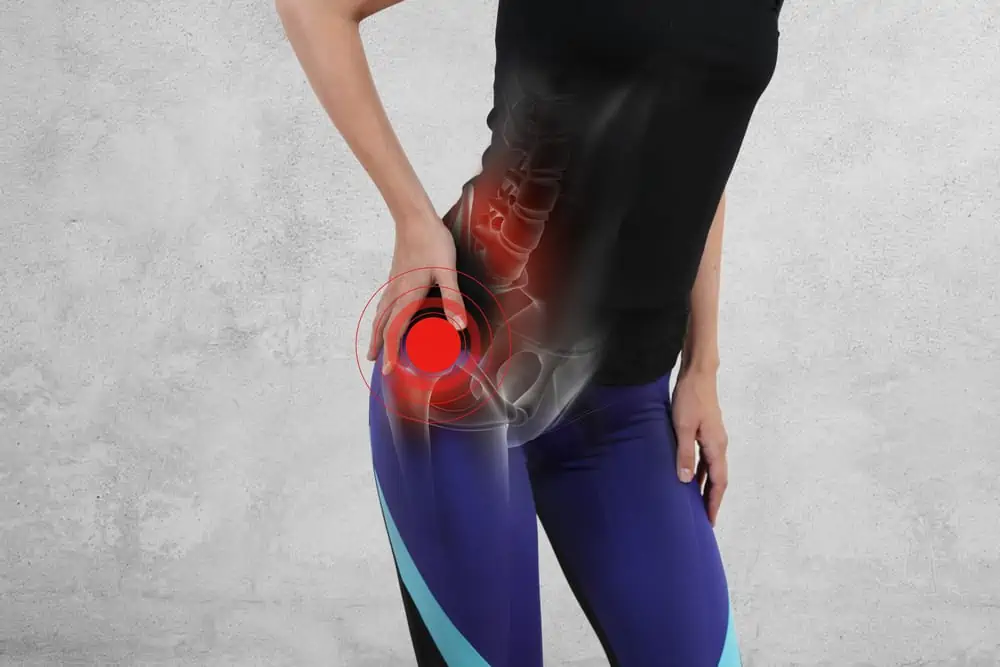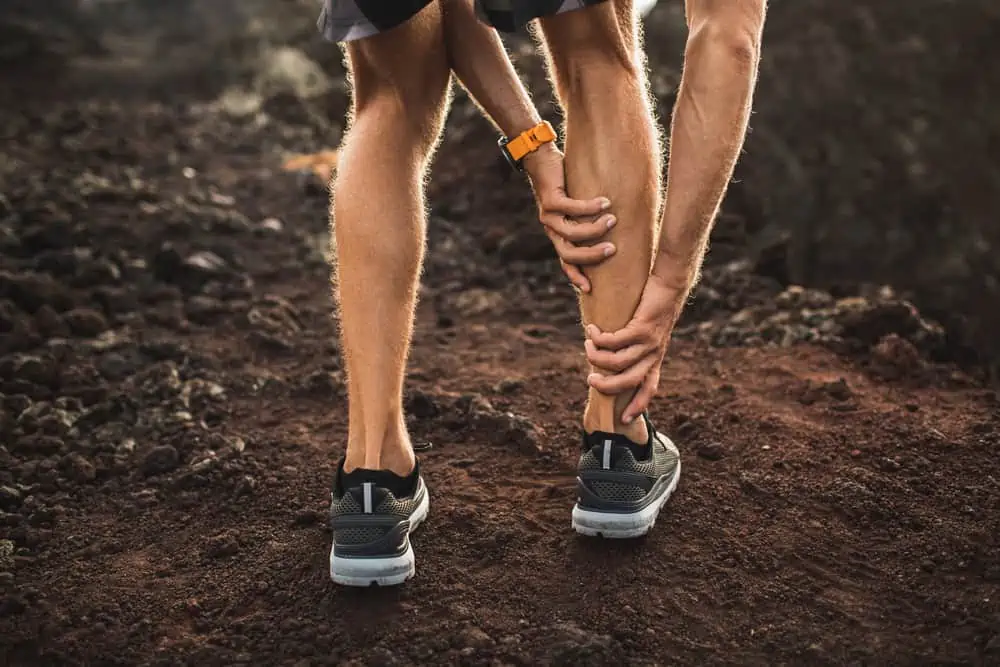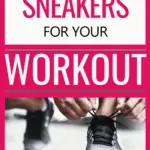This post may contain affiliate links. If you click through a link and make a purchase, I may receive a commission at no additional cost to you. As an Amazon Associate, I earn from qualifying purchases. Read the full disclosure here.
It can be tempting to just throw on any old pair of shoes, but this article will fill you in on why that’s a bad idea.
In general, it’s a good idea to wear shoes that match the type of activity you’ll be doing. Cross-training shoes tend to be the most versatile to suit a variety of workouts.
In this article, we’ll break down the major types of shoes and what they have to offer (or lack) for your workout.
Disclaimer: This content is for educational purposes and is not medical advice. Read the full disclaimer.
What shoes should I wear to the gym?
A proper shoe is one of the most essential components of your fitness routine. The answer to this question really depends on what types of workouts you do regularly.
Sneakers are built with different features suited for different workouts. In fact, wearing the wrong shoe can set you up for injuries like plantar fasciitis, foot pain, shin splints, meniscus tears, or even a total wipe-out!
I used to wear running sneakers for everything. Luckily, I never got an injury. They were my go-to shoes and felt fine.
When I started buying the right gym shoes for each type of workout, I noticed a huge difference! Now, if I’m accidentally wearing running sneakers, it feels completely “off” for me.
Today we’re breaking down some popular categories so you can feel way more confident the next time you buy workout shoes.
Related Read: 11 Signs You’re Wearing the Wrong Shoes for Your Workout
Running
Whether you’re running outside or on a treadmill, invest in a good pair of running shoes.
A running shoe provides cushioning and support as you roll through your foot during the gait cycle. They also come in different levels of support to complement your natural level of pronation.
Textured bottoms help give you a good grip on the surface to keep you from sliding around.
Brooks makes some of the best running shoes on the market, with plenty of styles for different types of feet.
For a lightweight, eco-friendly running shoe option, check out the Allbirds Tree Dasher.
A minimalist shoe (or barefoot shoe) allows you to “feel the ground,” but has less shock absorption and may not be the best choice for everyone.
Running shoes are excellent for running, but shouldn’t be mistaken as a one-stop shop for all your fitness shoe needs.
Walking
Many people use running shoes for walking as well, and find that a running shoe functions better than a traditional walking shoe. The higher heel-to-toe drop (the angle between the heel and the toe on a shoe) facilitates a smooth forward motion.
In general, walking shoes tend to be clunky and not very attractive.
This article by Very Well Fit goes in-depth on the differences between running and walking shoes and is an informative read if you’re in the market for this type of shoe.
Sneakers for cardio workouts
Running sneakers have a very textured, grippy bottom to provide traction. This is fabulous for running, but cardio classes that involve pivoting and twisting don’t play well with grippy bottoms.
As a physical therapist, I’m always down for setting yourself up for injury-free success. Knowing what not to do is just as important. I’ve seen meniscus tears and other knee injuries as a result of wearing running shoes to dance fitness classes.
Don’t be the next knee injury!
Cross-training shoes
Cross trainers are a gym shoe that works well for mixed cardio classes, kickboxing, HIIT, aerobics, and circuit training classes.
Look for a cross-training shoe with a smoother bottom to allow for pivoting as well as lateral stability for side-to-side movements. There is also some shock absorption during plyometric or high-level cardio exercises.
Read the details when searching for cross-trainers, some sneakers claiming to be cross trainers lack lateral stability. The training shoe category is becoming a loose term, make sure you get the features you’re looking for.
Here are a few of the best cross training shoes (made for both men and women) with great reviews:
I used to use the Nike Metcons and have slowly transitioned over to NOBULL Trainers. The NOBULLs require a bit more of a break-in period; however, I like the firm cushioning underneath the foot for stability without feeling like your joints are pressing into the floor.
I recommend going up 1/2 size for both options.
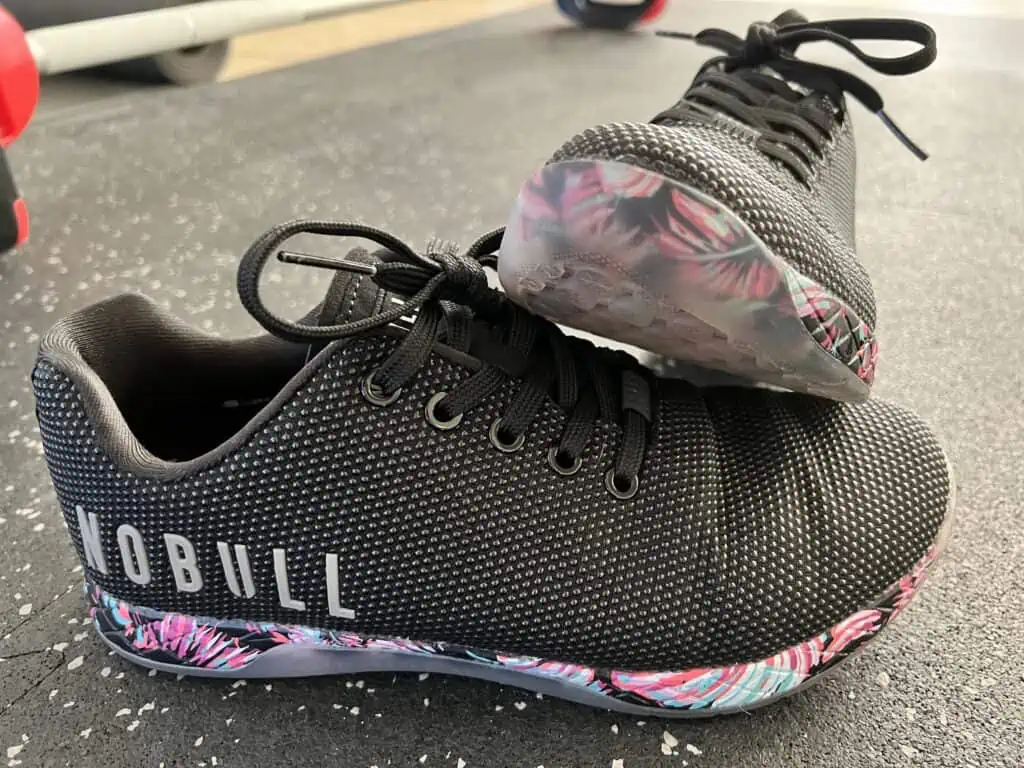
Shoes for strength training
For weight training, a stable shoe with less cushioning is a good choice. This allows for better stability and helps balance load.
A cross-training shoe is a good option, plus you can wear them for other workouts. Again, I love my NOBULL Trainers for strength training workouts.
Converse shoes tend to be a classic go-to for strength training, however I feel the NOBULL trainers offer more variety in terms of activities you can do.
For serious heavy lifting, a specific weight lifting shoe is an option. This type of shoe has a raised heel to help with form and a strap over the mid-foot to help keep you grounded. The raised heel helps if you lack ankle mobility and aims to improve movements like squats by balancing your path of movement.
This article by Crossfit Survival goes deep into the differences between cross-training and weight lifting shoes.
The bottom line, you shouldn’t be doing your strength training in cushiony running shoes, and a flat shoe doesn’t have to mean an uncomfortable shoe.
Dance fitness shoes
If you’re a Zumba or dance fitness devotee, check out dance sneakers!
They have more flexibility and a smooth bottom to allow you to get your samba on without sticking to the floor. And look like a pro.
Pivoting and twisting with a grippy running shoe can be a recipe for injury, especially for the knees.
Court sneakers
Sports like tennis, volleyball, basketball, or any other court-based sport all have their own category to provide stability, cushioning and support.
Shop for a sport-specific shoe to up your game.
NoBull now has a court trainer line that’s great for court-based sports.
Indoor cycle shoes
Do you love to spin? Invest in a pair of cycling shoes.
Cycle shoes are game-changers. They have specialized clips to keep your feet in place and a hard sole to support your foot during standing positions.
While you can ride the bike with your sneakers strapped into the cage, as you stand your shoes will bend and place additional stress on the mid-foot.
I just replaced my cycle shoes after 5 years of consistent use. You will get your money’s worth out of a good pair.
If you’re using regular sneakers during spin class, opt for shoes with a more supportive sole.
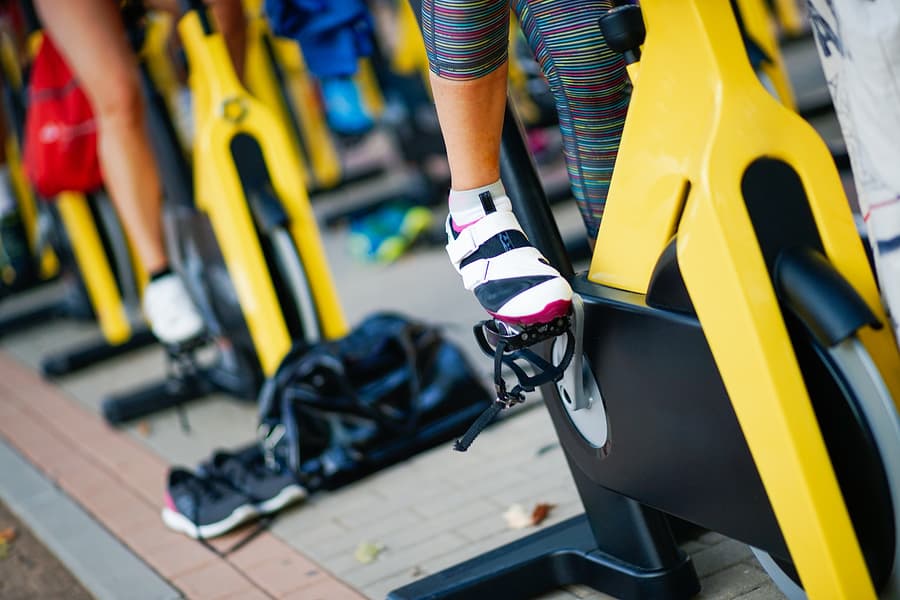
Yoga, Pilates, & barre fitness classes
Yoga, Pilates, and Barre classes don’t require shoes. Grip socks are an excellent option to provide more traction.
For Pilates and barre classes, flexible soled ballet shoes can give a bit more support if you have additional foot issues that cause discomfort while barefoot.
The Bloch Pilates Studio Shoe is a unique soft shoe option with a rubber heel, which may offer some support if you have heel pain or plantar fasciitis.
Some Barre and Pilates studios may have policies requiring socks, be just be aware.
What shoes NOT to wear for workouts
Avoid wearing casual sneakers or street shoes during exercise.
By casual sneakers, I mean non-athletic sneakers that were made for fashion, not function
Casual shoes are not designed to support and cushion your foot and ankle for exercise activities.
General fit considerations for athletic shoes
Try sneakers on with athletic socks. Look for sneakers that have plenty of room for your toes to wiggle and a snug fit cradling the heel and support thru the mid-foot.
You should never feel like there is excessive rubbing in any one area or like the foot is sliding or twisting inside the shoe. Consider going up a half size if you feel contact with the front of the shoe before exercising.
The goal is to be comfortable and well supported during activity. You can always add custom or over the counter inserts for additional padding or support. There is no shortage of athletic shoe brands, find the one that works for you.
If your exercise routine has variety, your sneakers should have the range to match.
Multiple options will extend the life of your footwear, meaning you will need to replace less often. Consider it an investment in your health.
How to tell when athletic shoes need to be replaced
The most visible signs of wear and tear are wearing the tread off the bottom of the shoe. If any part of the tread appears to be peeling off, this could be a tripping hazard.
Not so apparent signs include an increase in achy feet after a workout. Keep an eye out for pain in other places such as shins, calves, or knees, as this can also signal it’s time to get new shoes.
Related Read: 11 Signs You’re Not Wearing the Best Shoes for Your Feet
Wrapping up
What shoes should you wear to the gym? The proper style shoe for the main activity you’re doing. If you have a pair of running shoes and a pair of cross training shoes, you can cover a lot of bases.
Wearing the wrong shoes for fitness activities can cause foot, ankle, knee, hip, or even low back issues. Issues can arise over time and work their way up the kinetic chain.
Selecting the right workout shoe for each activity will help you avoid fitness injuries. Use these tips to build a gym shoe collection that works for you!
Featured image credit: Nick Aldi / bigstockphoto.com

